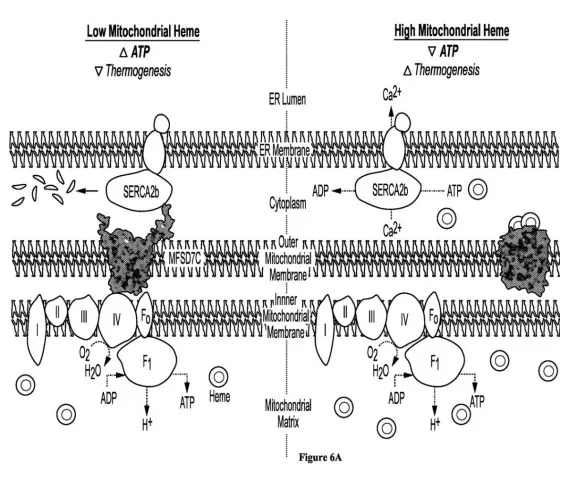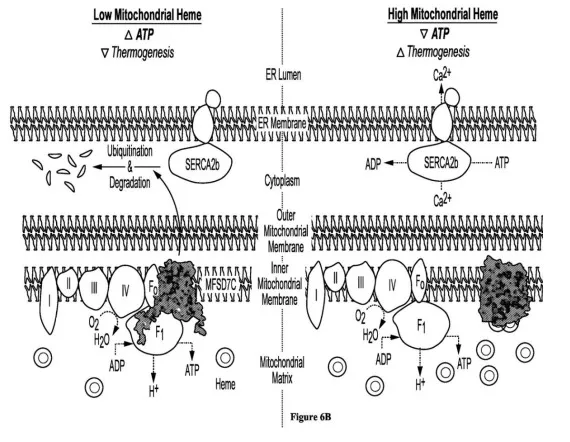Target for Modulating Body Mass
This invention utilizes a novel mechanism within the mitochondria of the cell to modulate metabolism, providing a method for treating obesity and related diseases. The discoveries may also be applied to promote weight gain.
Researchers
-
target for modulating body mass
United States of America | Published application
Figures
Technology
In typical cells, cellular respiration couples with ATP production, producing energy to fuel bodily functions. This technology utilizes heme, an iron-containing compound critical to cellular metabolism, to discourage ATP production and increase thermogenesis. Heme functions as an inhibitor of the membrane transport protein MFSD7C. With low heme levels, MFSD7C facilitates transporting potential energy through the mitochondrial membrane to produce usable ATP. When a sufficient amount of heme is administered to a subject, MFSD7C dissociates from the system, producing thermogenesis, releasing excess energy as heat and increasing oxygen consumption. This enables cells to match the outputs of mitochondrial respiration to the current metabolic state and nutrient supply within the body. Using the same principles, the results may also be reversed to decrease cellular respiration and promote weight gain in subjects.
The technology also provides a method for identifying additional possible inhibitors and activators for relevant transport proteins to achieve the desired results in metabolic regulation.
Problem Addressed
Obesity is a pressing health crisis, impacting individuals of all backgrounds and acting as a significant risk factor of numerous prevalent diseases. Obesity profoundly affects the overall quality of life, thus necessitating the creation of new treatment methods.
Cellular respiration is the process through which food is broken down to produce usable energy or heat. Cells generate the primacy energy source of the body by transferring potential energy through the mitochondrial membrane and converting it into adenosine triphosphate (ATP). In thermogenesis, uncoupling proteins redirect the potential energy to produce heat. Greater thermogenic activity increases energy expenditure, regardless of lifestyle.
Current obesity treatments focus on reducing energy intake by stimulating insulin production, decreasing blood sugar levels, and increasing feelings of satiety. This technology goes beyond weight management to improve overall cell fitness and physical health by targeting its mitochondria to increase thermogenesis and cellular respiration.
Advantages
- Expands on prior art by identifying specific membrane transport proteins as targets for drugs that promote energy dissipation through heat.
- Improves cellular respiration and oxygen consumption rate which has been shown to improve various diseases, offering a holistic approach to the health concerns of those suffering from obesity rather than purely focusing on weight management.
Publications
Li, Yingzhong, et al. "MFSD7C Switches Mitochondrial ATP Synthesis to Thermogenesis in Response to Heme." Nature Communications 11, no. 1 (September 24, 2020): 4837. https://doi.org/10.1038/s41467-020-18607-1.
Ivica, Nikola. "MFSD7C: A Solute Carrier Linking Heme and Calcium in Mitochondrial Energy Metabolism." Massachusetts Institute of Technology, 2021. https://dspace.mit.edu/handle/1721.1/139291.
License this technology
Interested in this technology? Connect with our experienced licensing team to initiate the process.
Sign up for technology updates
Sign up now to receive the latest updates on cutting-edge technologies and innovations.

